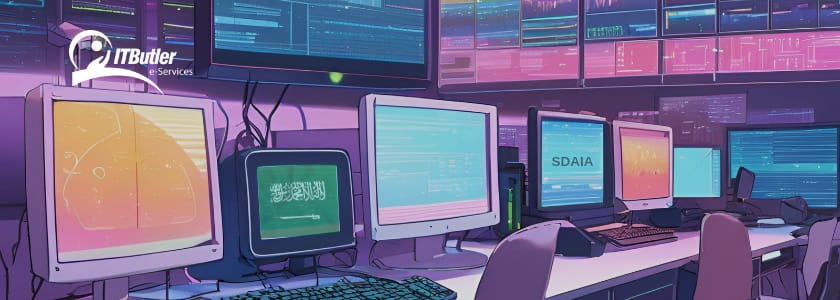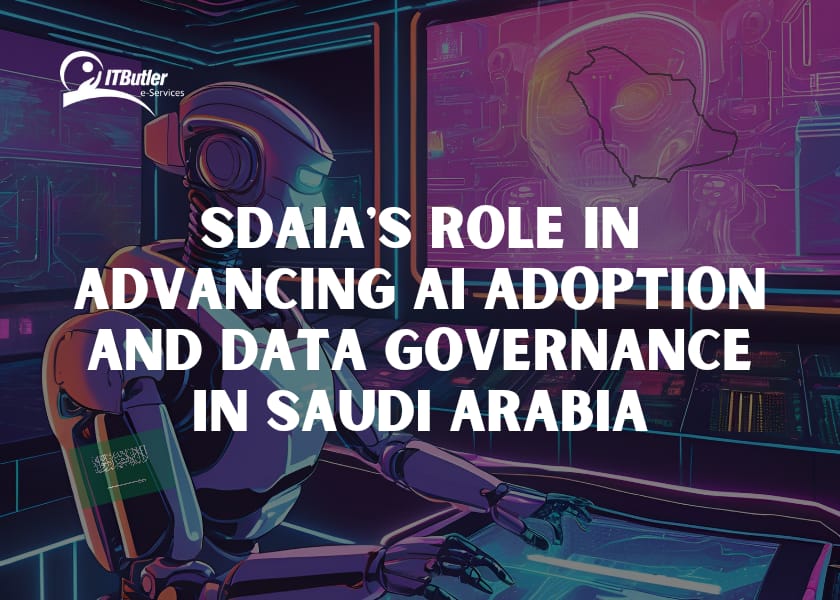Imagine a future where artificial intelligence runs your city, and daily chores, and makes all the decisions for an entire industry. Sounds like pure science fiction? However, in Saudi Arabia, it is becoming a reality due to the Saudi Data and Artificial Intelligence Authority. From securing your data to making sure AI works for everybody, SDAIA AI adoption is revolutionizing the Saudi.
But what exactly does SDAIA do to bring this new tech into our lives? How do they govern this powerful tool? Let’s discuss how it shapes Saudi Arabia’s AI future smartly and safely.
SDAIA AI Adoption Mission
Saudi Vision 2030 is making Saudi Arabia less dependent on oil and more dependent on tech. Do you know what a huge part of this plan is? “Artificial Intelligence”. So, that’s where Saudi Authority for Data and Artificial Intelligence (SDAIA) comes in. However, formed in 2019 SDAIA aims to manage data, implement AI technology, and aid in policymaking to propel innovation.
But AI isn’t just for supercomputers or high-tech labs. SDAIA is bringing AI into every industry in Saudi Arabia-from health care to finance, making it accessible and impactful.
AI Adoption Technologies
What rings in the head when hearing of SDAIA AI adoption would probably take over? But you can’t deny that AI has become a part of our lives, including voice assistants, and face recognition. Major fields covered by AI technologies include, and SDAIA is encouraging diverse sectors to adopt these:
1. Machine Learning
This is one of the most powerful tools in AI. Further, it allows systems to learn from data and make decisions with minimal human input.
- Supervised Learning: AI learns from categorized datasets, understanding the relationship between input and output.
- Unsupervised Learning: AI finds patterns from uncategorized data, thereby making sense of it all independently.
- Reinforcement Learning: However in this AI systems make decisions based on their interaction with their environment to bring about the best results.
- Deep learning: This is taking learning deeper by adding multiple layers of data processing similar to human capabilities. Further, it includes mimicking humans in tasks such as images or speech recognition.
Moreover, Saudi Arabia’s healthcare and finance industries are embracing such machine learning technologies for better results and efficiency.
2. Natural Language Processing (NLP)
SDAIA AI adoption to NLP allows machines to comprehend and create human language. Here is how it is put into use:
- Automatic Text Generation: SDAIA’s systems also contribute to automatically producing useful texts with less human effort and time.
- Question Answering: However, AI can now also answer user’s questions to enhance customer service in both the private and public sectors.
- Machine Translation: Furthermore, AI can translate texts in multiple languages and bridge the communication gaps in diversified businesses.
Consequently, the integration of NLP has enabled customer care, e-commerce, and government sectors to experience a change in Saudi Arabia.
3. Computer Vision
SDAIA is also investing in computer vision to process the visual data taken by cameras and lenses.
- Object Recognition: Artificial intelligence-based systems are enabled to recognize objects within images or video streams.
- Face Recognition: Further, AI aids in face recognition systems and enhances security and access management across all public and private establishments.
However, computer vision is a part of the Saudi tech used in its smart cities. It ensures security and system integrity for efficient traffic management.

4. Speech Recognition
Voice is one of the most natural sources of communication and is being translated into digital commands by AI.
- Speech-to-Text: AI can now recognize speech and turn it into written text, ideal for transcription applications.
- Text-to-Speech: However, AI can translate text into sound. As this is helpful for accessibility and customer service in various industries.
Saudi Arabia is taking great steps in public service with speech recognition, thus ensuring it becomes easy to communicate.
5. SDAIA AI Adoption of Robots
AI and robotics go quite hand in hand. As SDAIA promotes the use of AI for industrial robots as well as service robots:
- Industrial Robots: Industrial robots are used inside factories to perform tasks that automate the production, welding, or packaging of products.
- Service Robots: These help customers fulfill the expectations of the hospitality, health, and customer service requirements.
Saudi Arabia’s AI-powered robots are working in manufacturing and service industries to increase the level of productivity and efficiency.
SDAIA’s Approach to Data Governance
Now, we can’t discuss AI without mentioning data. After all, AI runs on data-so much of it! However, great power comes with great responsibility, but that is when the data governance policies come into effect by SDAIA.
Data governance can be likened to house rules for data. It is about ensuring that the right people have the right data at the right time. Moreover, SDAIA ensures that data is collected, stored, and used correctly. In this regard, the National Data Management Office and Artificial Intelligence Authority have set some rules and regulations. However, these rules indicate how data should be dealt with and handled by the Public and private sectors.
Why is that so important? As there is so much data flying around, you probably don’t want it to end up in someone else hands. Therefore, data governance protects your sensitive information to ensure proper AI systems utilize clean, reliable data.
SDAIA’s Artificial Intelligence Strategy
SDAIA is playing big for AI, it has a full-fledged strategy to present the kingdom on the world map as the AI leader. However, in 2020 Saudi Arabia unveiled its National Strategy for Data and Artificial Intelligence (NSDAI). It announced a target of being among the world’s top 15 AI nations by 2030.
So, what is the strategy about? It focuses on three important pillars:
1. Developing AI Talent
Similar to how one cannot have AI without those who know how to build and use it. However, SDAIA is partnering with the world’s universities and tech giants to develop this talent base.
2. Supporting AI Innovation
With SDAIA AI adoption, it supports early-stage companies and innovators who are working on AI projects. Moreover, they provide a sandbox, which allows companies to validate their solutions and receive real-time feedback.
3. Ensuring Ethical AI
To manage this phenomenon, SDAIA admits that AI is not a game. However, there’s an ethical impact, the privacy issues as well as bias in AI algorithms. Further, to use AI ethically we must implement clear instructions.
Future of AI in Saudi Arabia Beyond 2030
SDAIA AI adoption is still in its start-up stages in Saudi Arabia. However, the country aims to ensure AI contributes 12.4% of its GDP by 2030 which indeed is quite bold. Further, Saudi AI development will continue to mold those innovations into a responsible and effective fashion.
Whether it is something about robots potentially replacing your jobs or living in a completely smart city. There is one definite conclusion with AI. It has already been here and SDAIA will ensure that Saudi Arabia is ready for its future.
Conclusion
The role of SDAIA in how AI adoption and data governance can be harnessed in Saudi Arabia. However, they’re making it possible for the country to adopt AI while ensuring responsibly managed data. It is a huge task, yet through initiatives like the NSDAI, SDAIA AI adoption has been made smooth and effective.
